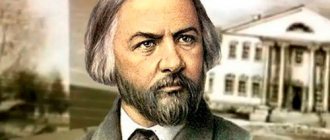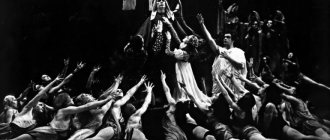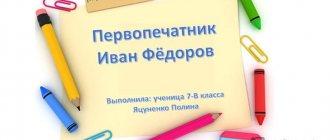Presentation “The Feat of Ivan Susanin”
Center for ART Education, All-Russian competition “Pride of the Fatherland”: Anniversaries of Russia in 2013 (history and culture)
Presentation for a history lesson.
Topic: The feat of Ivan Susanin.
History teacher: Mukhametzyanova Larisa Viktorovna
Student: Pisarev Ivan 7 “B” grade
MBOU "Secondary School No. 11" Almetyevsk
The village of Domnino, Kostroma region
Several years ago, in a swampy area near the village of Domnina, Kostroma region, local archaeologists during excavations discovered about forty unburied human remains. Among the fragments of skeletons, Catholic four-pointed crosses and one eight-pointed Orthodox cross, heavily chopped up, were found. The age of the remains and objects preserved next to them during the study was determined to be approximately 400 years. Archaeologists immediately put forward the version that the Orthodox cross belonged to Ivan Susanin, who was killed by the Poles, and the Catholic ones belonged to the same Poles and Lithuanians whom he led into the swamp.
Previously, based on the investigations of the Kostroma provincial scientific archival commission for 1896-1897, it was believed that Susanin was buried in the graveyard of the wooden tent-roofed Resurrection Church that existed in the 17th century. Some local historians claimed that Susanin’s body was buried not in Domnina, but in the village of Isupov near the Isupov marshes. But there were historians who believed that Ivan Susanin was not buried at all, since his remains, mutilated by the invaders, could not be found, and the news of his martyrdom comes from those few Poles and Lithuanians who managed to get out of the swamp and go to Bela Lake
.
Zemsky Sobor February 21/March 5, 1613
On February 21/March 5, 1613, the Great Zemsky Sobor in the Moscow Assumption Cathedral unanimously elected sixteen-year-old Mikhail Fedorovich Romanov, the grandnephew of Tsarina Anastasia Romanovna, to the throne.
Mikhail Fedorovich Romanov
However, Mikhail Romanov himself, like his father, Patriarch Filaret, captured by the Poles, was not at the Council. On October 28, 1612, Mikhail Fedorovich and his mother Marfa Ioannovna fled from the Moscow Kremlin captured by the Poles to Kostroma, and from there to their patrimony, the village of Domnino, 65-70 versts from Kostroma.
Marfa Ioannovna Romanova
According to legend, Marfa Ioannovna left her son in Domnino, under the supervision of Ivan Susanin and his son-in-law Bogdan Sobinin, and she settled not far from the Makaryev-Assumption Monastery, where Mikhail came on Sundays.
On March 20 (April 2), 1613, the Poles, having apparently learned about the election of Mikhail Fedorovich to the kingdom, sent a detachment to Domnino with the aim of capturing Mikhail Romanov.
Faithful people reported to Ivan Susanin about the approach of the enemy. He hid Mikhail in a pit of a burnt barn, covering him with smoldering firebrands - as if the fire had just happened.
Soon the Polish-Lithuanian detachment entered the village of Derevenki near Domnin, where Ivan Osipovich lived. Here the interventionists, as Susanin’s great-grandson I.L. Sobinin testified in 1731, organized an inquiry for local peasants, subjecting them to torture. Someone couldn’t stand it and said that Mikhail Romanov was in Domnina.
The Poles forced the elder Ivan Susanin to go with them as a guide to this village. Ivan Osipovich led the detachment away from Domnin, towards the swamps. But before that, he managed to give instructions to his faithful people to help Mikhail Fedorovich get out of the pit and run with him to Kostroma, to the Ipatiev Monastery.
Ipatiev Monastery
- Susanin, having led the enemy detachment ten miles into the disastrous swamp, decided that now the Poles would never catch up with Mikhail Fedorovich even with a faithful guide, stopped and admitted to deception. Despite the daggers pointed at his chest, he categorically refused to lead the “guests” back. Then the Poles attacked Susanin and began to torture him with “great, immeasurable tortures” and “tormented him to death,” as stated in the letter of Tsar Mikhail Fedorovich dated November 30, 1619.
Charter of Tsar Michael dated November 30, 1619.
Words from the historian Archpriest P. Ostrovsky about Susanin:
In 1864, relying on the research of Kostroma local historians, the historian Archpriest P. Ostrovsky wrote about how Ivan Osipovich Susanin behaved in these terrible moments: “... faithful to Christian duty, Susanin accepted the crown of martyrdom and blessed God, like the righteous Simeon of old. , who made him worthy, if not to see, then to die for the salvation of the youth, whom God anointed with holy oil and called him Tsar of Russia.”
What happened to the Romanovs after March 20, 1613?
As Ivan Susanin had hoped, they managed to take refuge in the Ipatiev Monastery.
Solemn embassy from the Zemsky Sobor.
A week later, on March 27, a solemn embassy from the Zemsky Sobor arrived here from Moscow and announced to Mikhail Fedorovich the will of the people to call him to the Russian throne.
Young Tsar Mikhail Romanov
Young Romanov refused this heavy burden, even cried.
Then Archbishop Theodoret took in his hands the Feodorovskaya Icon of the Mother of God, painted, according to legend, by the Evangelist Luke himself (with it Grand Duke Yaroslav Vsevolodovich blessed his son, the holy noble prince Alexander Nevsky, for marriage with the Polotsk princess Brechislava), and said to Mikhail and his mother: “ If you do not bow to mercy for our sake, then obey for the sake of the miraculous image of the Queen of all.” Then Martha Ioannovna led her son to the Feodorovskaya icon and, falling on her knees, said with tears: “Thy will be done, Lady! Behold, Most Pure Mother of God, I commend my child to You: guide him on the path of truth, for the benefit of yourself and the Fatherland.”
Crowning of Mikhail Romanov
On July 11, 1613, the day the young sovereign turned 17, he was crowned king.
Used Books
- Umbrellas N. A.
Ivan Susanin // Ivan Susanin: legends and reality. - Kostroma, 1997. - P. 27. - 352 p. - Umbrellas N. A.
Ivan Susanin: legends and reality // Questions of history. 1994, N 11; - Solovyov S.
History of Russia since ancient times - Umbrellas N. A.
“For service to us, and for blood, and for patience...” // almanac “Kostroma Land”. 1992, N 2 S. 39-54; - Tolstov V. A.
N. I. Kostomarov and V. A. Samaryanov: two views on the historical authenticity of the personality of Ivan Susanin // Time of Troubles and zemstvo militias at the beginning of the 17th century. To the 400th anniversary of the creation of the First Militia under the leadership of P. P. Lyapunov. Collection of proceedings of the All-Russian Scientific Conference. Ryazan, April 11-12, 2011 / Rep. ed. Doctor of History, Prof. V. N. Kozlyakov. Ryazan, 2011. pp. 249—257
"Ivan Susanin" ("Life for the Tsar")
Ilya Repin. Portrait of Mikhail Glinka. 1887
Fedor Fedorovsky. Set design for the final scene of Mikhail Glinka's opera "Ivan Susanin". 1939
Set design for Mikhail Glinka's opera "Ivan Susanin". 1951. Illustration: art16.ru
1. The idea of creating an opera about the feat of Ivan Susanin was suggested to Glinka by his friend Vasily Zhukovsky: “... as if by magic, suddenly a plan for an entire opera was created, and the idea of contrasting Russian music with Polish music; finally, many themes and even details of development - all this flashed into my head at once,” the composer later recalled.
2. Working on an opera has its own canons: it is customary to write music based on the word. However, Glinka acted on the contrary, which created difficulties in creating the poetic text of the libretto. Nestor Kukolnik, Vladimir Sologub, Prince Vladimir Odoevsky and Zhukovsky himself tried to keep up with Glinka’s music. But for the most part only Baron Georg von Rosen succeeded. What Glinka most appreciated was his ability to compose words for ready-made music: “Rosen had already prepared poems laid out in his pockets, and I had to say what kind, that is, size, I needed and how many poems, he took out so many of each type, as much as necessary, and each variety from a special pocket. When the size and thought [did not] fit the music and [did not] agree with the course of the drama, then extraordinary stubbornness appeared in my piet. He defended each of his verses with stoic heroism.”
3. The audience did not appreciate Glinka’s music and even called it “peasant”, “coachman’s”, “common”. In the opera “Life for the Tsar,” the composer turns to the genre of Russian folk song, trying to show the national flavor. This was alien to court listeners, accustomed to numbers in the spirit of the Italian aria. But Nicholas I was very pleased with the opera and, as a sign of his admiration, gave Glinka a diamond ring.
4. After the revolution of 1917, attempts were made to change the plot of the opera and transfer it to Soviet realities: “The first edition was to transfer the time of action to the era of the Bolshevik revolution. In accordance with this, Ivan Susanin turned into a “chairman of the village council” - into an advanced peasant standing up for the Soviet homeland. Vanya was converted to a Komsomol member. The Poles remained in place because at that time there was a war with Poland, where Tukhachevsky advanced.” The final anthem was paraphrased: “Glory, glory, Soviet system” (Leonid Sabaneev. “Memories of Russia”).
Peter Williams. Sketch of the set "Dominino" for Mikhail Glinka's opera "Ivan Susanin". 1939. Illustration: tamart.ru
Drawing based on Mikhail Glinka’s opera “Ivan Susanin”. Illustration: intoclassics.net
Fedor Fedorovsky. Set design for Mikhail Glinka's opera "Ivan Susanin". Theater named after Kirov. 1940. Illustration: megabook.ru
Summary of a music lesson on the topic “Opera “Ivan Susanin” (7th grade)
Lesson topic: “Opera “Ivan Susanin”
A new era in Russian music. Human destiny is the people's destiny. My motherland! Russian land"
Organization of the lesson “...He who is Russian at heart is cheerful and courageous,
And joyfully dies for a just cause!
Neither execution nor death and I am not afraid:
Without flinching, I will die for the Tsar and for Rus'!”
K. Ryleev
Teacher: Hello, guys! Do you love to travel? Today we have an unusual music lesson. We are going to the opera house. Sit comfortably in the auditorium.
(1st row - “Parterre”, 2nd row - “Box”, 3rd row - “Mezzanine”).
Teacher: Our first row is the spectators of the stalls, the lower floor of the auditorium, the second row is the guests of the box (a small room with a separate entrance, separated from the neighboring ones by side partitions), and the third row is located in the mezzanine (the first tier of the auditorium in the theater).
Main partTeacher: Who wrote the first Russian opera and when did it appear?
Students: M.I. Glinka, in 1836. And it was called “Life for the Tsar” or “Ivan Susanin”. She talks about the events that took place 400 years ago, when Minin and Pozharsky stood at the head of the people's militia against the conquerors of the Russian land - the Polish army.
Teacher: Who is the main character of this opera?
Students: The hero of this opera is the Kostroma peasant Ivan Susanin, who dies for the Fatherland.
Teacher: The Poles demand to be shown the way to Moscow.
Ivan Susanin, planning to lead the enemy into an impenetrable thicket, proudly answers them
Most of the opera was written before the words: I think such a curious story has never happened to any opera. The fact is that Glinka’s first thought was not to write an opera, but something like a painting, as he said, or a symphonic oratorio. The entire musical creation, in its main features, was already in his head; I remember that he wanted to limit himself to only three paintings: a rural scene, a Polish scene and the final triumph. The high patriotism and noble citizenship of the Ryleev Duma, whose hero gives his life for his homeland, were close to Glinka’s consciousness. Zhukovsky became his adviser and even composed the text of the opera's epilogue, and recommended Baron Rosen, the secretary of the heir to the throne, as a librettist. The text was composed to ready-made music; the entire layout of the action belonged to the composer. Glinka's opera tells about the events of 1612 associated with the campaign of the Polish gentry against Moscow. The struggle against the Poles acquired a nationwide character. The enemies were defeated by Russian militias led by Minin and Pozharsky. One of the most striking episodes of this struggle was the feat of the peasant of the village of Domnina, Ivan Susanin, about whom numerous Kostroma legends tell. The majestic image of the peasant, who has become a symbol of heroism and patriotic loyalty, is embodied in the opera as a living folk type, endowed with a wealth of thought, depth of feelings, shown against the broad background of Russian folk life and nature.
W. The opera consists of four acts with an epilogue.
Let's get acquainted with the main characters of the opera: Ivan Susanin, a peasant of the village of Domnina, Antonida (his daughter), Vanya (Susanin's adopted son), Bogdan Sobinin, a militia soldier, Antonida's fiancé.
Contents of the opera
1612 A period known in history as the “Time of Troubles.” The Poles are trying to enslave Rus'. The path of the Polish army was marked by looting and fires. In Susanin's native village, they are waiting for their native warriors to return from the campaign. The women look sadly at the river and sing about the beauty of their native land. Suddenly the same song comes from the river. This is them, the long-awaited native warriors! The entire village poured out onto the shore to meet them. Susanin on the porch of his hut. His daughter Antonida is waiting for her fiance, the leader of the military detachment Bogdan Sobinin. Sobinin and the soldiers go ashore. They sing a song about the difficult fate of their Motherland and the tenacity of its fighters. Young village militias come out to meet them. The commander of a militia detachment sings about their readiness to defend the Motherland together with the soldiers. Bitter moments of remembrance for those who did not return from the battlefield. But the joy of meeting and victory outweighs the grief. Here comes the girl with the bread and salt! Everyone remembers the former adversaries and German dog knights drowned in Lake Miracle, and the Tatar horde that perished on the Kulikovo field. All of them left Russian soil without a meal. The scene ends with a cheerful, but also threatening song: “Trouble to all uninvited evil guests!” Susanin’s words sound soberingly: “It’s too early for us to rejoice...”. Meanwhile, Antonida carefully tries to ask when the wedding with Sobinin is. There will be no wedding until all enemies are driven out from their native land. This news shocks Sobinin - after all, he rushed home for the wedding during a break between fights. One of the best pages of the opera sounds - the trio “Don’t be tormented, my dear...”, which ends with a general – almost prayer – for peace. Sobinin's story that the Poles are locked in the Kremlin by Russian troops and that Minin is gathering a militia to completely defeat the enemies again inspires hope for a joyful victorious hour, for peace - and a cheerful wedding. Everyone goes home. Winter. In Susanin's house, preparations are underway for the wedding, but the girls who came with a wedding song to the bachelorette party find Antonida alone in the hut sobbing. She tells (Antonida's romance) that a detachment of Poles rushing to Moscow to the rescue of the Polish army forced Susanin to serve as their guide and Susanin, secretly sending his adopted son Vanya for help, left with the enemies. Having agreed to serve as a guide to the Poles, Susanin deliberately led them into the wilderness and off-road, from where they had no way out. The tired squad is sleeping. Susanin cannot sleep: he has a presentiment of his death at the hands of enraged enemies. The music-stunning aria “They sense the truth” sounds. Meanwhile, Vanya, having driven his horse, ran to the gates of the forest settlement, where the militia led by Minin was spending the night. Vanya tells the militia that the enemy is close. The militia with Vanya goes to the rescue of Susanin. But they were late. Susanin died, hacked to death by the sabers of enraged enemies. The Polish detachment was defeated and destroyed. Susanin died like the Russian people who selflessly and heroically gave their lives for their native land, for their people. And so - the enemies were expelled from their native land. Rus' is free and independent again. Victory! On Red Square in Moscow, people glorify their Motherland, the fighters who defended it from the invaders, and remember the heroes who gave their lives for Rus'.
Act one The peasants of the village of Domnina, among whom are Ivan Susanin, his daughter Antonida and his adopted son Vanya, meet the people's militia. The people are determined to defend their homeland. “Whoever dares to attack Rus' will find death. Everyone disperses, leaving only Antonida. She yearns for her fiancé Bogdan, who is gone to fight the Poles. The girl’s heart tells her that her boyfriend is alive and is hurrying to her. And indeed, in the distance the song of the rowers can be heard: it is Bogdan Sobinin with his squad. Sobinin brought good news: the Nizhny Novgorod peasant Minin is gathering a militia to liberate Moscow captured by the lords and finally defeat the Poles. However, Susanin is sad: the enemies still dominate their native land. He refuses Sobinin and Antonida’s requests for their wedding: “There’s no time for weddings these days. It's battle time! Act two Magnificent ball at the Polish king Sigismund. Intoxicated by temporary successes, the Poles proudly boast of the loot they plundered in Rus'. Panenki dream of famous Russian furs and precious stones. In the midst of the fun, a messenger from the hetman appears. He brought bad news: the Russian people rebelled against their enemies, the Polish detachment was besieged in Moscow, the hetman’s army was fleeing. The dancing stops. However, the boastful knights, in the heat of enthusiasm, threaten to capture Moscow and capture Minin. The interrupted fun is resumed. Act three Vanya, Susanin's adopted son, makes a spear for himself, singing a song about how his named father took pity on him and sheltered him. Susanin, who entered, reports that Minin came with the militia and settled down in the forest. Vanya confides his cherished dreams to his father - to quickly become a warrior and go to defend his homeland. Meanwhile, Susanin’s family is preparing for the wedding. Peasants come to wish Antonida well. Left alone, Antonida, Sobinin, Susanin and Vanya talk about their joy - this long-awaited day has finally arrived. Then Sobinin leaves. Suddenly the Poles burst into the hut. Threatening Susanin with death, they demand to be taken to Minin’s camp and to Moscow. At first, Susanin refuses: “I’m not afraid of fear, I’m not afraid of death, I will lie down for Holy Rus',” he says proudly. But then he conceives a bold, daring plan to lead his enemies into the wilderness and destroy them. Feignedly seduced by money, Susanin agrees to lead the Poles to Minin’s camp. He quietly tells Vanya to quickly run to the suburb to gather people and warn Minin about the invasion of enemies. The Poles take Susanin away. Antonida cries bitterly. Meanwhile, Antonida’s clueless girlfriends come with a wedding song, and then Sobinin and the peasants. Antonida talks about what happened. The peasants, led by Sobinin, rush in pursuit of the enemies. Act four. At night, Vanya comes running to the fence of the monastery suburb. An alarm is raised in the camp, the soldiers arm themselves and prepare for the campaign. Susanin leads his enemies further and further into the wilderness. They are wondering where the Russian peasant has taken them. “I brought you there... where you will die from a fierce blizzard! Where are you going to starve to death!” — Susanin answers with dignity. In vicious bitterness, the Poles kill Susanin. Epilogue. Picture one. Decorated crowds of people pass by the gates leading to Red Square. The bells are ringing festively. Everyone praises the Tsar, Great Rus', the Russian people, and their native Moscow. Here are Antonida, Vanya, Sobinin. When asked by one of the warriors why they are so sad, Vanya talks about the heroic deed and death of his father. The soldiers console them: “Ivan Susanin will live forever in the people’s memory.” Picture two. Red Square in Moscow is filled with people. The glory of Rus' sounds powerfully. The soldiers turn to Susanin's children with words of consolation. Minin and Pozharsky appear. The people greet the glorious commanders. A solemn greeting sounds.
RESULT OF THE LESSON:
Teacher: Today we...






